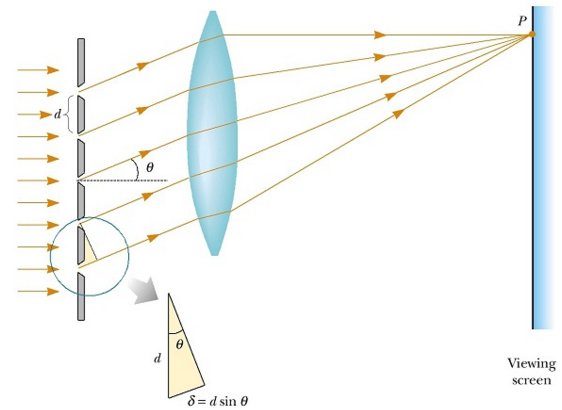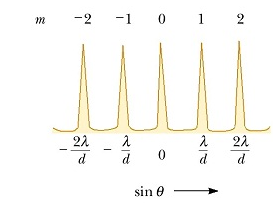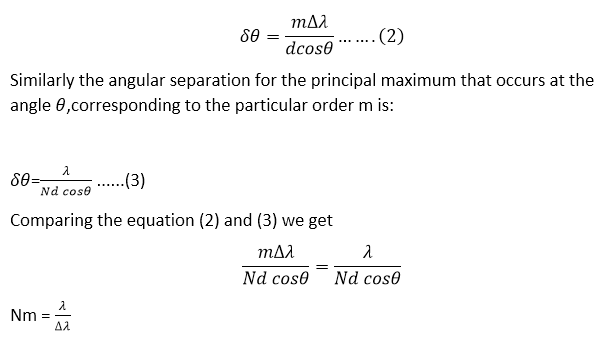How does a Diffraction grating work?
“The diffraction grating is a useful device for analyzing light sources. It consists of a large number of equally spaced parallel slits.” Its working principle is based on the phenomenon of diffraction. The space between lines acts as slits and these slits diffract the light waves thereby producing a large number of beams that interfere in such a way to produce spectra.
A transmission grating can be made by cutting parallel lines on a glass plate with a precision ruling machine. The space between the lines is transparent to the light and hence acts as separate slits. A reflection grating can be made by cutting parallel lines on the surface of refractive material. Gratings that have many lines very close to each other can have very small slit spacing. For example, a grating ruled with 5000 lines/cm has a slit spacing d=1/5000 cm=2.00×10-4 cm.

A section of a diffraction grating is illustrated in the figure. A plane wave is an incident from the left, normal to the plane of the grating. A converging lens brings the rays together at point P. The pattern observed on the screen is the result of the combined effects of interference and diffraction. Each slit is produced diffraction, and the diffracted beams interfere with one another to produce the final pattern.
The waves from all slits are in phase as they leave the slits. However, for some arbitrary direction θ measured from the horizontal, the waves must travel different path lengths before reaching point p. From the figure, we note that the path difference’ δ ‘ between rays from any two adjacent slits is equal to d sin θ. If this path difference is equal to one wavelength or some integral multiple of a wavelength, then waves from all slits are in phase at point P and a bright fringe is observed. Therefore, the condition for maxima in the interference pattern at the angle θ is.
Diffraction grating formula
d sin θ =mλ
Where m=0,1,2,3,4…
We can use this expression to calculate the wavelength if we know the grating spacing and the angle 0. If the incident radiation contains several wavelengths, the mth-order maximum for each wavelength occurs at a specific angle. All wavelengths are seen at θ =0, corresponding to m=0, the zeroth-order maximum (m=1) is observed at the angle that satisfies the relationship sin θ =λ/d: the second-order maximum (m=2) is observed at a larger angle θ, and so on.

The intensity distribution for a diffraction grating obtained with the use of a monochromatic source. Note the sharpness of the principal maxima and the broadness of the dark areas. This is in contrast to the broad bright fringes characteristic of the double-slit interference pattern. Because the principal maxima are so sharp, they are very much brighter than double-slit interference maxima.
Grating element definition
Distance between two consecutive slits (lines) of the grating is called a grating element. Grating element ‘d’ is calculated as:
Grating element =Length of grating/Number of lines
Dispersion and resolving power
Dispersion
The ability of a grating to produce spectra that permit precise measurement of wavelengths is determined by two intrinsic properties of grating.
- The separation Δθ between the spectral lines that differ in wavelength by small amount Δλ.
- The width or sharpness of the lines.
The dispersion D of the grating is defined as:
“The angular separation Δθ per unit wavelength Δλ is called the dispersion D of the grating.”
D = Δθ/Δλ
For lines of nearly equal wavelengths to appear as widely as possible, we would like our grating to have the largest possible dispersion.
Since the grating equation is:
d Sinθ =mλ
Differentiating the above equation we have:
d cosθdθ = mλ
Now in terms of small differences the above equation we have:
d cosθ dθ =m dλ
Now in terms of small differences, the above relation can be written as:
d cosθ Δθ =mΔλ
Δθ/Δλ =m/d cosθ
D = m/d cosθ
From the above relation, we see that the dispersion D increases as the spacing between the slits ‘d’ decreases. We can also increase the dispersion by working at higher-order ( large m). Note that the dispersion does not depend on the number of rulings N.
Resolving power definition
“The resolving power of an instrument is its ability to reveal minor details of the object under examination.”
Resolving Power of grating
“The resolving power of grating is a measure of how effectively it can separate or resolve two wavelengths in a given order of their spectrum”.
The diffraction grating is most useful for measuring accurately. Like the prism, the diffraction grating can be used to disperse a spectrum into its wavelength components. The grating is the more precise device if we want to distinguish two closely spaced wavelengths.
According to Rayleigh’s Criterion ” For two nearly equal wavelengths λ1 and λ2 between which a diffraction grating can just barely distinguish, the resolving power R of the grating is defined as:
R = λ/Δλ
Thus, a grating that has a high resolving power can distinguish small differences in wavelength.
Where λ = λ1 + λ2 /2 and Δλ = λ1 – λ2
Thus, resolving power increases with the increasing order number and with an increasing number of illuminated slits. If the lines are to be narrow, the angular separation δθ is small, then corresponding wavelengths interval Δλ must be small, and by equation(1) the resolving power must be large. To find the physical property of the grating that determines to resolve power R, we write the spacing between nearby lines as:

⇒R = Nm
Thus resolving power increases with the order number m and number of lines N.Resolving power is independent of the separation d of the slits.
Watch also video:
External source
- https://en.wikipedia.org/wiki/Diffraction_grating
- http://hyperphysics.phy-astr.gsu.edu/hbase/phyopt/grating.html
This is so good thank you so much please keeping postings great answer likes this onces again thank you